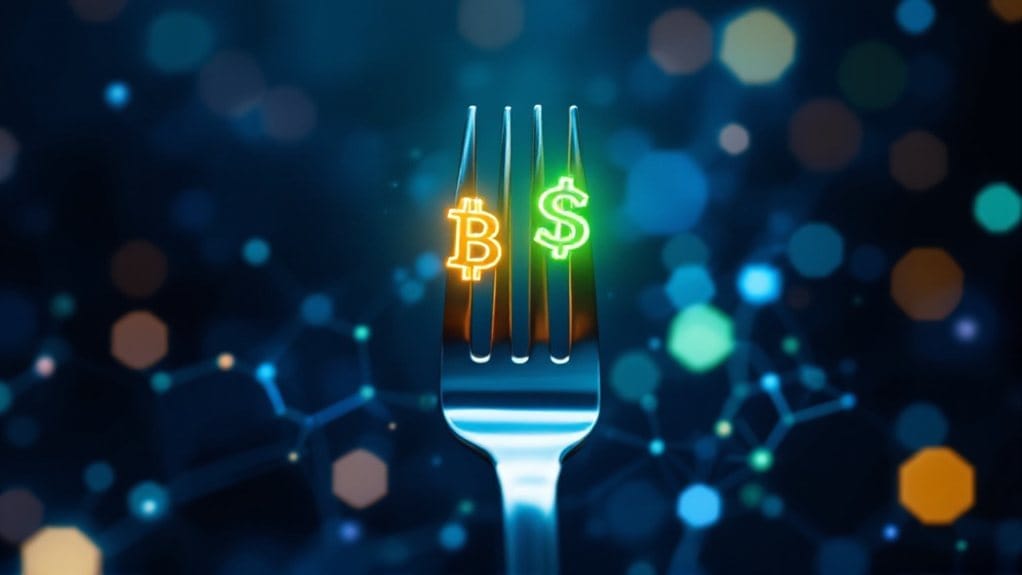Decentralized Applications (DApps) are blockchain-based software programs that operate autonomously through smart contracts, eliminating the need for centralized intermediaries. These applications function on peer-to-peer networks, primarily Ethereum, where transparent transactions are validated and executed automatically. DApps improve security through distributed networks while giving users control over their data and assets, despite facing challenges with scalability and transaction costs. The evolving DApp ecosystem continues to transform industries from finance to gaming, offering innovative solutions for those seeking truly decentralized interactions.

While the technological environment continues to evolve, Decentralized Applications (DApps) have emerged as a transformative advancement in software architecture, operating autonomously on blockchain networks without centralized control. These applications utilize smart contracts to manage their backend logic, employing blockchain technology to create transparent, secure, and user-controlled environments where transactions and interactions occur without intermediaries. Front end interfaces remain similar to traditional web applications, but operate on fundamentally different backend principles.
Decentralized Applications revolutionize software by enabling autonomous, blockchain-based systems that eliminate intermediaries through smart contract integration.
DApps operate on peer-to-peer networks, with Ethereum being a prominent blockchain platform for their development and deployment. The foundation of these applications relies on smart contracts, self-executing agreements that automatically process transactions when predetermined conditions are met, with approximately 75% of DApps utilizing a single smart contract for their operations. These contracts, once deployed, remain largely immutable, ensuring consistent functionality and reducing the risk of unauthorized modifications. Today, only 15.7% of DApps maintain complete open-source code, marking a shift from traditional DApp development practices. The Ethereum Virtual Machine executes these smart contracts, ensuring secure and reliable transaction validation across the network.
The decentralized nature of DApps provides several advantages over traditional applications, including improved security through distributed networks, transparent transaction records maintained on public ledgers, and increased user autonomy over data and assets. Users can interact directly with these applications while maintaining ownership of their information, contrasting sharply with centralized systems where data control often resides with service providers.
Despite their innovative features, DApps face notable challenges in their implementation and adoption. Scalability issues often result in slower transaction processing times and increased costs, particularly during periods of high network traffic. The execution of complex smart contracts requires gas fees, which can fluctuate greatly based on network conditions and computational demands.
Furthermore, the user experience remains a vital concern, as interacting with DApps often requires technical knowledge that may deter mainstream adoption.
The technology continues to evolve across a range of industries, including finance, gaming, and social media, demonstrating its versatility and potential for innovation. Through consensus mechanisms like Proof-of-Work or Proof-of-Stake, DApps maintain security and reliability while enabling developers to build upon existing platforms, creating an ecosystem that promotes continuous progress in decentralized technology.
FAQs
How Do DAPPS Handle User Data Privacy Compared to Traditional Applications?
DApps offer improved data privacy through decentralized storage and smart contracts, eliminating central authorities’ control over user information.
Users maintain granular control over their data through self-sovereign identity solutions, allowing selective disclosure of personal information.
However, DApps face unique challenges, including blockchain’s immutability conflicting with privacy regulations and potential metadata exposure, while public ledger transparency can compromise user anonymity despite robust cryptographic protections.
What Programming Languages Are Most Commonly Used for Developing DAPPS?
Several programming languages dominate dApp development, with Solidity being the primary choice for Ethereum-based applications and smart contracts.
JavaScript, particularly with Web3.js, enables front-end development and blockchain interactions, while Rust powers high-performance applications on Solana.
Vyper offers an alternative to Solidity with improved security features, and Go (Golang) supports blockchain infrastructure development, especially on platforms like Hyperledger Fabric.
Can DAPPS Operate Without Cryptocurrency or Tokens?
While DApps can theoretically operate without cryptocurrencies or tokens, most implementations require them for practical functionality.
The blockchain infrastructure typically needs tokens for processing transactions, incentivizing network participants, and executing smart contracts.
Some DApps utilize non-monetary tokens for governance or access control, but completely tokenless systems face significant technical challenges in maintaining decentralization and ensuring network security through alternative consensus mechanisms.
How Do DAPPS Generate Revenue if They’re Decentralized?
DApps generate revenue through multiple established mechanisms, despite their decentralized nature.
Primary revenue streams include transaction fees from user activities, yield generation from liquidity provision, and token-based economics.
Moreover, DApps monetize through NFT sales, subscription services for premium features, and advertising partnerships.
The decentralized structure allows for autonomous fee collection and distribution, while smart contracts automatically manage revenue allocation to stakeholders and protocol maintenance.
What Happens to a DAPP if Its Development Team Abandons the Project?
When a development team abandons a DApp, the project can continue functioning due to its decentralized nature and blockchain infrastructure.
The smart contracts remain operational on the blockchain, ensuring basic functionalities persist, while user data stays secure and accessible.
Open-source code allows the community to maintain and improve the DApp, though scalability issues and technical updates may become challenging without dedicated development support.









